Culture Watch

COMPLETELY BY COINCIDENCE, travel writer and translator Shahnaz Habib once joined thousands of pilgrims in Lalibela, Ethiopia. Habib’s trip happened to overlap with Ethiopian Christmas, which brings Ethiopian Orthodox Christians from across the country and world to the town, famous for its medieval rock-hewn churches.
Detailing her experience in her book Airplane Mode, a personal history of travel with a sharp eye for the colonial legacies in tourism, Habib calls Lalibela’s churches “marvels of subterranean engineering.” Carved from red volcanic rock, they sit embedded in the ground, connected by tunnels. The complex of structures was built in the 12th century as an homage to Jerusalem, complete with replicas of Christ’s Nativity crib and tomb.
Habib observed as her fellow travelers lined up around the churches to kiss crosses offered by priests: “A kiss at the top of the cross, a kiss at the bottom, a touch of the cross to the forehead. Hundreds of kisses every hour.” She noted the procedural quality of the ritual.
“To lose oneself in a crowd. To walk the beaten path. To wait and be bored,” she writes. “Perhaps what separates the tourist and the pilgrim is not the reasons for their travel but the satisfaction that the pilgrim finds in what frustrates the tourist.”
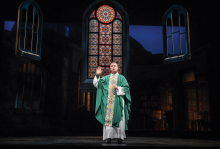
IN THE LAST nine months, John Patrick Shanley has had three plays on and off Broadway: revivals of “Doubt” and “Danny and the Deep Blue Sea,” and the debut of “Brooklyn Laundry.” While the timing is completely coincidental, the three plays cover much of his career: “Danny” premiered more than 40 years ago, and “Doubt” recently turned 20.
Despite the decades between them, these plays share a surprisingly consistent take on faith. Though raised Catholic, today Shanley demurs from identifying with any one religion. In a recent interview he told me, “It’s like when you’re among theists, you get handed a piano with 88 keys and told you can only use 13. I think that human spiritual experience is first of all mysterious and second of all, extremely rich and varied. Any reduction is just that, a subtraction from the breathtaking panoply available to us through the history of the spirit.”
In “Danny,” “Doubt,” and “Brooklyn,” God is not a comfort. Instead, Shanley’s characters are confronted with the radical, unavoidable uncertainty of reality — and challenged to go forward anyway. For Shanley, the whole idea of faith demands stripping away anything sentimental or reassuring. It isn’t faith if it isn’t well and truly a leap.
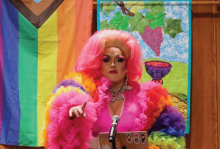
PREACHER ACTIVIST AND drag queen Marge Erin Johnson walked up to the wooden lectern at Fort Washington Collegiate Church in Manhattan wearing a sequin rainbow dress and high hot pink wig. “I want to give an extravagant welcome to the LGBTQIA+ community,” she said, “especially those of us that have been burned by the demonic homophobic and transphobic flames of the church. You are welcome here. And lastly, a special welcome to those who are here today — whether you are queer or straight — but for some reason, you feel more seen and comfortable and heard because there is a drag queen at the pulpit.”
Marge Erin Johnson is the drag persona of James Admans (they/them), a nonbinary minister, currently ordained, pending call, in the United Church of Christ. A graduate of Union Theological Seminary, Admans served as assistant minister at Fort Washington Collegiate Church where they coordinated an LGBTQ+ ministry called Beyond Labels, and edited the 2022 anthology Beyond Worship: Meditations on Queer Worship, Liturgy, and Theology. They are most well-known, however, for hosting drag church services where LGBTQ+ individuals can feel affirmed and welcomed back into spaces that may have caused immense trauma.
Marge told Sojourners that drag church “might be exactly what we need to remind us of the beauty and diversity and God’s infinite love for all.” But her ministry comes at a time when drag culture itself is under fire from U.S. conservatives. According to the ACLU, there are 319 anti-LGBTQ+ bills under deliberation or passed into law in the United States. These include legislation that would censor books with queer characters or ban trans youth from sports, and several anti-drag bills that could make performing drag to younger audiences illegal. These bills, often used to create moral panic by associating trans people and drag queens with sexual endangerment of children, are in large part created and supported by Christians.
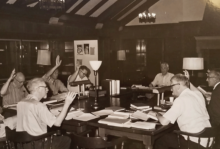
WHEN THE FULL Revised Standard Version of the Bible was released in 1952, the translation used “young woman” instead of “virgin” in Isaiah 7:14, which so enraged conservatives like Rev. M. Luther Hux that he publicly burned that page of the Bible. This would not be nearly the most impactful RSV translation, however, as the new film 1946: The Mistranslation That Shifted Culture seeks to explain.
1946 (named for the year the RSV New Testament was released) aims to measure the drastic effects of the RSV being the first Bible translation to use the word “homosexual.”
The film follows the research by Kathy Baldock and Ed Oxford on the RSV translation, with supplementary scholarship from other academics who help explain the RSV’s rendering of the Greek words malakoi and arsenokoitai as “homosexual.” It also traces the cultural ripples of this translation, which the film asserts helped anti-LGBTQ+ Christians demonize and ostracize queer people. Finally, it shows the relationship between the film’s director Sharon “Rocky” Roggio, a lesbian, and her father Sal Roggio, a conservative pastor.
Translating portions of the Bible can be tricky business. As scholars note, arsenokoitai is a word with few other uses across the ancient world and may have been invented by the apostle Paul. Literally, it is a combination word that means “man who beds with males,” connotating a sexual usage. Malakoi means “soft,” and is understood as referring to “effeminate” men.
In the American Standard Version, a common translation that preceded the RSV, the translation used for arsenokoitai is “abusers of themselves with men.” The RSV later changed its translation to “sexual perverts,” though at the time, this was code for LGBTQ+ people. After the RSV, the New International Version used “men who have sex with men,” while the New Revised Standard Version used “sodomites.” The NRSV’s Updated Edition, released in 2021, uses “men who engage in illicit sex,” while noting that the meaning of the Greek is uncertain.

THE AD FOR Text With Jesus promised “A Divine Connection in Your Pocket.” Developed by Catloaf Software, the app is an artificial intelligence chatbot that takes on the persona of the Alpha and Omega. In the paid version of Text With Jesus, you can also chat with Mary, the 12 apostles, Moses, and dozens of other biblical characters, including Satan (if you dare to enable him in the settings menu). Cue eye roll.
In November 2022, ChatGPT went public. With Generative AI now at our fingertips, offering conversational responses to users’ prompts, the AI revolution was officially in full swing. Tech giants such as Google, Microsoft, and OpenAI raced to provide the most accurate, engaging chatbot. But no one has taken the messianic furor around generative AI quite as literally as Catloaf.
A few years before launching Text With Jesus, Catloaf president and CEO Stéphane Peter had created Texts From Jesus, an app that sends users a daily Bible verse. In an email interview with Sojourners, Peter explained that the innovation of ChatGPT offered “a compelling new element of interactivity.” Instead of a static quote from the New Testament the new app lets users have conversations with an AI Jesus.

THE DEVIL IS irresistible horror bait, the central figure in some of the best scary movies ever made. A tour through Satan’s oeuvre finds plenty of examples of an outside force of evil, such as Al Pacino’s diabolical attorney tempting Keanu Reeves in The Devil’s Advocate (1997) or Elizabeth Hurley’s sensual temptress raising hell for Brendan Fraser in Bedazzled (2000). These movies generally have the theological heft of a Carman music video, but occasionally, Hollywood tries an angle on Satan that’s a bit more sophisticated, spooky, and, ultimately, instructive. Take, for instance, John Carpenter’s low-budget 1987 box-office flop Prince of Darkness.
The movie follows professor Howard Birack (Victor Wong) and his students as they investigate a mysterious green ooze in a monastery’s basement. The team discovers that the slime is the literal embodiment of Satan, a twisted take on the consecrated host. While we get a brief glimpse of a giant red figure with black fingernails, Prince of Darkness doesn’t focus there. Instead, the danger is far more immediate. Anyone exposed to the slime is possessed by its essence, transformed into a mindless murderer. The true adversary remains in the shadows, sowing mistrust and division. The only thing our heroes can attack is each other.

WHEN I WAS a student at Earlham College in Indiana, I co-hosted an alcohol-free dance party. Fry House, which was owned by the university, held a reputation for wild parties before we established it as Interfaith House in 1997. We — a group of religiously observant and spiritually curious undergrads — wanted to bring a new spirit into our house. I had been to enough drunken high school parties that I chose not to drink in college, other housemates had parents with alcoholism, and some abstained for religious reasons. We posted flyers, twisting a beer slogan into our hook: “Why ask why? Try Fry Dry!”
When the big night came, we pushed the furniture aside, laid out snacks, turned up the music, and swallowed our pride when only one person showed up.
This memory returned when I noticed with some surprise how Dry January, which has an app called “Try Dry,” has become a global movement. In 2013, the nonprofit Alcohol Concern (now “Alcohol Change UK”) invited people to abstain from alcohol in January; 4,000 people signed up. In 2022, 130,000 people signed up, with many more participating around the world. As alcohol-related deaths, especially among women, rose in that same period, Dry January began to take hold.

The school district is back to bipartisan leadership, but exclusionary policies and white supremacy have not lost their stranglehold.

I KNOW WHAT it’s like to be baptized in the meltwater of a dying glacier. It feels like a plunge into all the emotions of living in our climate-changed world: joy, dread, awe, fear, love.
In August, a few of my college friends and I took a trip, something of a pilgrimage, to Glacier National Park in Montana. We wanted to visit the glaciers that are projected to die off in the coming decades. The Kootenai people call this place Ya·qawiswitxuki,“the place where there is a lot of ice.” It is a place burdened with names that it will hold on to even after the glaciers and ice disappear.
The geology of the park is like a cake cut open to show layers of sandstone, shale, and limestone — a portal into deep time. About 100 million years ago, in an event called the Sevier Orogeny, the mountains in Glacier formed as the forces of colliding tectonic plates thrust two billion years’ worth of sedimentary rock upward. Across 100,000-year cycles, glaciers formed and retreated, slowly whittling away at the rock and carving out dramatic valleys, moraines, arêtes and horns, cirques and tarns. During a simple four-hour hike, we walked through billions of years of sedimentation.
Walking through such a place makes this moment in history seem both insignificant and deeply important. Thousands of feet of layered sediment formed organically, with nearly no human influence, but the small sliver at the top will be markedly human. This Anthropocene layer in the geologic cake holds markers of nuclear bombs, cow manure, and a lot of plastic. It holds the most dramatic increase in carbon concentration and the accompanying increase in temperature. It holds the extinction of hundreds of creatures, which may soon include the western glacier stonefly and meltwater lednian stonefly, who require ice-cold clear streams to survive.
This layer is also the moment, a blink of an eye in geologic time, when the mighty glaciers disappear. It is estimated that by 2100, two-thirds of the world’s glaciers will be killed. The reality is more devastating in the eponymous national park, where all the glaciers are expected to be gone by the end of this century. I can’t predict all the impacts the park will feel over the next 75 years, but I imagine that the numerous hikers currently making pilgrimages to the glaciers will instead walk in funeral processions to plaques, like the one marking the death of the Okjökull Glacier in Iceland.

IN RATTLING THOSE DRY BONES: Women Changing the Church, activist and author Susan Cole writes an essay in response to the question, Why do I remain in the church? In her answer, she shares how she healed her relationship with God through the figure of Sophia, who she defines as “the Wisdom of God, the divine imaged as female.” Cole writes, “Through [Sophia] I have discovered in a whole new way, divine presence within myself, within my sisters, within all that is.” Cole’s portrait of a female God, filled with kindness and joy, stands in stark contrast to the millennia of androcentrism that shapes Christian teaching and practice. The treasure of the Christian female godhead remains buried, but it can be uncovered.
Sophia sits (metaphorically) at artist Judy Chicago’s “The Dinner Party,” the famed feminist installation anchored by an enormous triangular banquet table, 48 feet long on each side. From 1974 to 1979, Chicago scrupulously created unique, historically precise place settings for 39 “guests of honor,” female figures both mythical and historical, ranging from Mother Earth to Georgia O’Keeffe. An additional 999 names appear written on tiles surrounding the table. According to Brooklyn Museum curators, at Chicago’s table Sophia stands as a powerful “creative force in the universe” and a cross-cultural symbol of a female God. And the elements of Sophia’s place setting — a flower plate with watery petals and a runner made from remnants of a wedding veil — symbolize Christianity’s role in “the downfall of female power, particularly religious power.” On a grand scale, “The Dinner Party” reminds us of what patriarchy has erased.
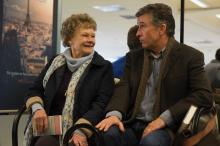
THE BEST CHRISTIAN MOVIE you’ve never seen (even though it was Oscar-nominated for best picture!) turns 10 this year. That movie is Philomena, adapted from The Lost Child of Philomena Lee: A Mother, Her Son and A Fifty-Year Search, by British journalist Martin Sixsmith. The film stars Dame Judi Dench as the titular mother and Steve Coogan as Sixsmith. While the book primarily focuses on Philomena’s son Michael Hess, the film more closely traces the mother’s story. As a pregnant teenager, Philomena was abandoned to a convent of nuns who forced young women to work without pay and sold their children to wealthy Americans looking to adopt.
On her son’s 50th birthday, Philomena weeps, clutching the only pictures she has of him. Despite her efforts, she has never been able to learn his fate. When Sixsmith, a disgraced journalist, learns of Philomena’s plight, he agrees to help her. What began as a distraction from his own troubles soon shifts to captivation. Despite Philomena’s assurances that the sisters of the convent have done their best to care for the women and children in their charge, Sixsmith uncovers a devilish conspiracy of silence.

RICH MULLINS HAD a museum of a personality. The singer-songwriter, who died in a car accident in 1997, loved to show off anything he found interesting, his friends say. From music to movies to the places he traveled, Mullins loved “for you to experience what he loved,” his friend and collaborator Mitch McVicker told Sojourners.And more than just about anything else, Mullins loved Jesus.
Mullins’ career tracked alongside the evolution of contemporary Christian music (CCM), which went from marginal in the 1970s to a powerhouse genre that sold a combined 31 million albums in 1996. Best known for the modern hymn “Awesome God,” Mullins wrote his fair share of songs that fit Christian radio. But more often, his music was a kaleidoscope of faith and humanity, offering a tour of human frustration and failure.
On “Hard to Get,” Mullins, as modern psalmist, asks God, “Do you remember when you lived down here, where we all scrape to find the faith to ask for daily bread? / Did you forget about us, after you had flown away?”
In other places, Mullins plays minor prophet. “I wrote this for the Religious Right,” he declared before singing that Jesus “came without an axe to grind [and] did not toe the party line,” during a performance of “You Did Not Have a Home.”

“DO YOU MAKE any money from it?” a visitor asked as we walked behind my house, where goats, chickens, fruits, and vegetables grow among the weeds. I shook my head and laughed.
We entered the garden where my 74-year-old father knelt, breaking up soil with an old cultivating fork. He was planting spindly tomato plants I had started from seed and almost abandoned.
We don’t make money from it, but the garden is the place where my father cultivates joy. When I was a child, he poured water on rows of collards to wash away stressful days working for a Washington, D.C., nonprofit. Gardening restores his soul. These days, Dad splits his time between my parents’ home in Ohio and my home in rural Georgia, planting gardens in both places.
We don’t weigh the bushels of okra, cantaloupe, peppers, watermelon, and beans to see if they equal or surpass expenditures of time or money spent on Dad’s trips down South. Some work can’t be measured in dollars.

AT THE CLOSE of the music video for “$20,” all three bandmates of boygenius — the young indie band turned chart-topping supergroup — cut their palms and swear a blood oath to each other. As I watched it for the first time, I couldn’t help but feel drawn toward prayer — is this what love looks like? It is subversive to hold on to the tenderness of friendships in a world rife with violence. But boygenius, consisting of Julien Baker, Phoebe Bridgers, and Lucy Dacus, refuses to do anything less in their debut full-length album the record — a searing homage to their love for each other. It is nothing short of divine.
Ringing with angst and affection, these songs meld post-grunge guitar riffs with heartfelt existential threads. In “Satanist,” they respond to ruminations in Ecclesiastes 1:2, “Everything is meaningless,” by singing, “If nothing can be known, then stupidity is holy.” By embracing the finitude and vapor of our existence, they, like the Teacher in Ecclesiastes, “[make] peace with [their] inevitable death” (from the song “Anti-Curse”).
Yet, amid all the nihilism, there’s joy. Boygenius’ gushing piano ballad “Letter to an Old Poet” nods to Rainer Maria Rilke’s Letters to a Young Poet, in which the Austrian writer and mystic offers this instruction: “Believe in a love that is being stored up for you like an inheritance.” Boygenius finds this love in friendship.
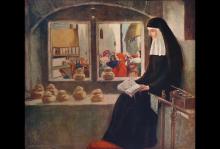
JULIAN OF NORWICH, the 14th-century anchoress and mystic in England, prayed for an embodied understanding of suffering. As she wrote in Revelations of Divine Love, she desired “three graces” from God: “to relive Christ’s Passion”; “bodily sickness”; and the wounds of “contrition,” “kind compassion,” and “purposeful longing for God.” At age 30, on what she presumed to be her deathbed, Julian received a series of divine visions — equally euphoric and terrifying — that taught her about the all-encompassing nature and nearness of God’s love. In one vision, Julian saw Christ’s head bleeding profusely from the crown of thorns.
But these images did not bring her a message of despair. Julian wrote, “This is our Lord’s will: that we yearn and believe, rejoice and delight, take comfort and console ourselves as much as we can, with his help and his grace, until the time when we can see it truly for ourselves.” Through pain and contemplation, she developed a deeply embodied faith. Reading her work healed years of spiritual pain for me. In the Catholic context of my upbringing, shame led to disembodiment and antagonism toward my body. Julian, by contrast, envisioned human wholeness — in mind, body, and soul.

WHEN EMILY DICKINSON first read the novel Jane Eyre, she didn’t know the name of its author. At the time, Charlotte Brontë wrote under the pseudonym Currer Bell, and her work was the subject of controversy. The British Quarterly Review referred to Bell as “a person who ... combines a total ignorance of the habits of society, a great coarseness of taste, and a heathenish doctrine of religion” and said, “the tone of mind and thought which has overthrown authority and violated every code human and divine ... is the same which has also written Jane Eyre.”
When Dickinson returned Jane Eyre to the friend who lent it to her, she sent it with a bouquet of box leaves and a note that makes it clear she’d heard the gossip on Bell. She wrote, “If all these leaves were altars, and on every one a prayer that Currer Bell might be saved — and you were God — would you answer it?” Years later, when Brontë died, Dickinson wrote the following elegy: “Oh, what an afternoon for heaven, / When ‘Brontë’ entered there!”
As Dickinson’s biographer Alfred Habegger notes, this elegy not only grants Brontë salvation but also “made heaven the beneficiary.” Even in these brief notes on Brontë, we can see some of the common themes of Dickinson’s poetry. There is the impulse to engage with (and even affirm) the ideas of God and heaven but also the impulse to subvert rigid and exclusive notions of theology.
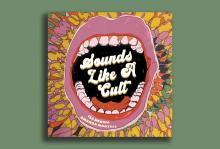
WHAT DO CELEBRITY megachurches, a cappella groups, nonprofits, and Trader Joe’s have in common? According to author Amanda Montell and comedian Isabela (Isa) Medina-Maté, they’re all cults. In their hilariously informative podcast, Sounds Like A Cult, launched in 2021, these are just a few of the groups they eye with suspicion. Across episodes, the duo focuses on a group, institution, or brand with a fanatical following and ask, “This group sounds like a cult, but is it really?”
Whether they are calling out the hypocrisy of Starbucks’ refusal to let their workers unionize or critiquing the ways Taylor Swift weaponizes her loyal fan base to dismantle outlets that might portray her negatively, no brand, organization, or person is safe. They often have guests who have escaped (or sometimes still are in) said “cults,” and at the end of each episode, Medina-Maté and Montell share whether that week’s subject fits under one of three categories: a “Live Your Life” cult, a “Watch Your Back” cult, or a “Get the [Expletive] Out” cult. Listening to them is akin to eavesdropping on a conversation between friends, and the tone can switch from serious to breezy in the same breath. “All billionaires are cult leaders, period,” Montell says in an episode about Starbucks. In an episode about church camps, she notes that camps are great at “weaponizing endorphins and calling it the Holy Spirit.” The hosts are alternately analytical, easygoing, and earnest, but they never belittle their subjects for the sake of laughs.

BEFORE HE STEPS onstage as Ike Turner in TINA: The Tina Turner Musical, Garrett Turner (no relation) does a simple ritual: He swirls a wooden mallet along the rim of a Tibetan singing bowl. As the sound washes over him, he focuses on himself as Garrett, not Ike the musician and abusive ex-husband of the “Queen of Rock ’n’ Roll.” And he prays.
“Tina found Buddhism on her way to liberation from Ike, and it was something that Ike decried,” Garrett told me a few days after I saw him perform in Atlanta. Embracing something that Ike pushed away helps Garrett become Ike onstage while remaining Garrett within. With eight shows a week for the touring Broadway production, this spiritual practice helps Garrett draw a clear line between himself and the broken man he portrays.

HBO’S BIGGEST POST-APOCALYPTIC SHOW, The Last of Us, imagines a brutal world — and the mushroom zombies are only occasionally the source of danger. The first season followed Joel (Pedro Pascal), as he escorted teen Ellie (Bella Ramsey), who is immune to the zombie infection, to a hospital that can turn her immunity into a cure. In the final episode [SPOILERS], Joel and Ellie reach their destination. But when Joel learns they can only manufacture the cure by killing Ellie, he kills the doctor who was set to operate on Ellie. Joel’s decision raises the question: If the world can only be saved by sacrificing the innocent, is it a world we want to save? The Last of Us, itself an adaptation of a beloved video game, is far from the first show that employs apocalypse to interrogate our morality. Our end-time imaginings can show us who we are ... and who we could be.
The Greek title of the last book in the New Testament canon is Apokalypsis (“apocalypse”), the best English rendering of which is “revelation.” Revelation isn’t about the end of the world. It’s about a revelation — an unveiling. Revelation is one example from the genre of books we call apocalyptic literature. The genre, popular among Jews and Christians for hundreds of years before and after Jesus’ life, usually features a human receiving a message from some sort of divine messenger. The messenger wants to show the listener some deeper truth about the world — something that helps the audience participate more faithfully in the new world God is bringing forth.

A STORM BLOWS through Weyes Blood’s fifth album, And in the Darkness, Hearts Aglow. A cold front of disillusionment meets the swirling tones of songwriter Natalie Mering. The effect is gorgeous and staggering.
Sounding both in and out of their time, these songs fuse darkly majestic orchestral arrangements with pop elements such as drum machines, synthesizers, and the occasional guitar. If history took a later start, this could be our classical music. Weyes Blood (pronounced “Wise Blood,” a nod to Flannery O’Connor’s novel set in the “Christ-haunted” South) has said that she craves sanctuary acoustics.
Billowing and hymn-like, “God Turn Me Into a Flower” is the album’s truest prayer. “It’s good to be soft when they push you down,” Mering sings. She sings to stand firm, but never aspires to twist into bramble: “... it’s such a curse to be so hard / You shatter easily and can’t pick up all those shards.”